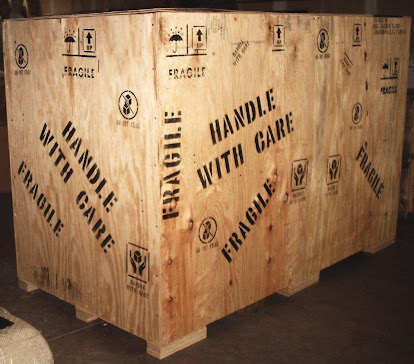
Artists the world over have encountered the dilemma of how to get their works to their paying customers, who - thanks to the power of the internet and the worldwide marketing it provides - often do not live nearby. And since artists are in the unique position of having to pack and ship one-of-a-kind works that would be nearly impossible to recreate, the art packing process is incredibly crucial to artists (who, by definition, are also small business owners).
Which brings us to our point. Matisse, Picasso, Wyeth, Warhol, Rockwell: what do all these famous artists have in common? All these artists and more have been packed and successfully shipped by Navis Pack & Ship locations. Navis Pack & Ship has always been known as the leaders in specialty packing and logistics solutions, and we're happy to report that the art world is booming and we are shipping more fine art than ever. Which puts us in the special position to be an authority on professional packing and shipping of fine art to ensure each work arrives in perfect condition. Transporting fine works of art is an art in and of itself: there are many techniques for wrapping, packing and transporting art, depending upon the piece (it's no surprise that ten foot tall sculptures require far different packing and shipping methods than 8x10 inch canvas paintings). We're also excited to be in the position to share some of our tips with artists in the hopes of helping them navigate the unnerving waters of packing and shipping art. Of course, if you're trying to ship enormous or incredibly heavy pieces, it's probably best to go with a professional (Navis Pack & Ship uses custom crating, so each work is uniquely packaged).
The following are several simple steps to ensure safe handling and transport of art:
Wrapping art
-
Begin with a clean workspace free from dust and liquids that has enough room to safely work. It is recommended to use dust and lint free gloves to protect your art.
-
Inspect the piece for any loose paint, cracks and check the condition of the frame.
-
Wrap the piece entirely with Glassine, which is acid free, taking care to overlap the edges and seal securely. Take care to ensure the Glassine is not touching the surface of the art.
-
The next layer of protection is a wrapping of Polyethylene Foam, 1/8” to 1/4” thick, or bubble packaging(with bubbles facing out) which will provide additional cushioning and protection from humidity.
-
Cut two sheets of corrugated cardboard sized to ½” longer than the width of the frame. Place one sheet on your work surface, lay your art face down and then place the second sheet on top. Secure with 4” stretch wrap or tape. (Alternately, for added protection, cut one to size and the second larger than the frame and score it so that it folds over the sides of the frame.) Be sure to label the front of the piece.
-
If the piece is framed in glass, special care is necessary to apply Glass Skin or a low tack tape to give the glass strength as well keep it together should there be any breakage. It's usually best to pack the glass separate from the surface of the work so the piece isn't damaged if the glass breaks.

Choosing a container
-
Many factors go in to the selection of your container—value, fragility, time in transit, etc. But the piece you're shipping is the one factor that contributes most to the container used to ship the work. For shipping small, lightweight works - such as a canvas painting or a small two dimensional display item - the foam, carboard and tape wrapped package can be placed inside a typical box with packing peanuts and be kept perfectly safe during transit. But for highly fragile, valuable, large, or heavyweight works - such as glass items, stone sculptures or large three dimensional display items - significantly more care is required to ensure a safe arrival.
-
Navis Pack & Ship uses wooden crates for maximum protection. We custom build each crate to accomodate the piece and its accessories with zero wiggle room. If you have the ability to create your own crate container, we highly recommend this option because it nearly eliminates the risk of damage. Or bring it in to one of our locations!
-
Choose a container that is at least 2” larger in all dimensions, but 3-4” is best for maximum protection. Measure the wrapped piece precisely, and add 4 to 8 inches to all three measurements to determine the container size, depending upon the amount of desired cushioning you choose.
-
Remember that the container you use to pack your art for shipping is an investment in the piece. If it will be impossible or cost prohibitive to replace the work, do whatever you can to ensure a safe arrival.
Interior Cushioning
-
Like containers, there are several options of cushioning to choose from depending on the weight and fragility of the piece.
-
The two most often used materials are open-celled polyurethane foam or, if packing a heavier piece of art, closed-cell polyethylene foam.
-
Using the known void space in the box, measure and cut the foam to fully line the box or secure strips along each side, no more than 12 inches apart ensuring full corner protection. It is not necessary to fill the void with any other material with this method. Smaller, less fragile works, however, can be cushioned with packing peanuts filling the void space completely.

Art Transit
-
Depending upon the size, weight, fragility, and value of the piece different transit options are available.
-
Air is the fastest mode of transportation and is necessary for high value pieces of art. Time in transit and carrier possession is kept very limited and handling is at a minimum, which typically makes air transit among the highest price point.
-
Ground transportation options can vary from standard to expedited, including direct drive truck or pad wrap options for larger works of art.
-
Standard ground is often the harshest environment for shipping art with maximum shock and vibration - this may or may not matter depending on the type of art being shipped.
-
Climate conditions can also widely vary within the various modes of transit. If this is an important consideration, there are climate controlled vehicles available for transport, although they are costly. If climate is of concern, but not worthy of a climate controlled environment, lining the box or crate with polystyrene material can provide some additional insulation.
We hope these guidelines can be used to help artists pack and ship their works safely! And of course, we welcome any artists into our shops and promise to provide the highest quality packing and shipping materials and methods available to make sure each piece arrives securely at its destination.

